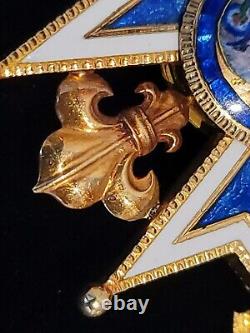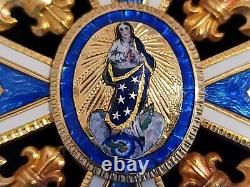Antique Gold Royal Spanish Order Charles III Isabella Catholic Medal Award Spain













For your consideration is an exceedingly rare and historically important c. 1830's antique 18K Gold Royal Spanish King Ferdinand VII issue Order of Charles III Commander Grand Cross, featuring a miniature gold Collar of the Order of Isabella the Catholic. This is an extremely early issue gold Order of Charles III. Enameled suspension ring featuring the colors of the Order (Blue-White-Blue). (Real y Distinguida Orden Española de Carlos III). A white boarded and blue-enamelled Maltese Cross in Gold, with Gold fleur-de-lis in each quadrant, obverse centre applique depicting St. Mary in enamel, reverse centre with cypher of Charles III, measuring 55 mm (w) x 95 mm (h - inclusive of laurel wreath and integral ring). Weight is 35.69 grams. Condition is original / fine.
Due to the long lifespan of this Order, there are great deal of variation in the sizes, composition materials, and design attributes of the Order's grades. These features highly affect the price of the item. The Order is also known as the Order of Charles III; and the Order of the Immaculate Conception. The Royal and Distinguished Order of Charles III (Real y Muy Distinguida Orden de Carlos III) was established by King Carlos III/Charles III of Spain on September 19, 1771, to mark the occasion of the birth of his grandson Carlos V/Charles V, future heir of the Spanish thrown. It was dedicated to Immaculate Conception, and was confirmed by Pope Clement XIV on February 21, 1772.
Originally, it was awarded to individuals who had displayed actions that enhanced the prestige and goals of the Spanish crown. The Order had two original grades, i. The Grand Cross, and Knight. The Commander by Number was added in 1783 while the Knight of the Collar was added in 1878.
The Dame's Bow was incorporated in 1983. However, with the consecutively Restoration of the Bourbon's House, the Order was finally restored.Since its founding, it has been considered the most prestigious civil order within Spain. Currently, the Order is conferred upon Spanish and foreign citizens for extremely meritorious domestic and foreign service to Spain. There are five grades; Collar, Grand Cross, Commander by number, Commander, and Knight. The Order is conferrable upon women with the suffix Dame instead of Knight.
The Order depicts an inscription that stands to "Virtuti et Mérito" (Virtue and Merit,) which is located on the reverse of the crosses, alongside the cipher of Carlos III. The earlier versions of the Grand Cross have an enameled suspension ring featuring the colors of the Order (Blue-White-Blue). The later versions of the Grand Cross have the suspension ring composed of gold or gilt, without any enamel. There are rare examples of the Grand Cross with reversed enamel colors on the central medallion, with a blue background and a white border.
The Royal Order of Isabel la Católica is a distinction of Spain, instituted by King Ferdinand VII on March 14, 1815, with the name of Royal and American Order of Isabel la Católica, in order to reward refined loyalty and merits contracted in favor of the prosperity of those territories. The order was reorganized by a royal decree of July 26, 1847 and took its current name. The last regulation was approved by royal decree in 1998.
Its current function is to reward extraordinary civil behavior, carried out by Spanish and foreign people, that benefit the Nation or that contribute, in a relevant way, to favor relations of friendship and cooperation of the Spanish Nation with the rest of the International Community.

